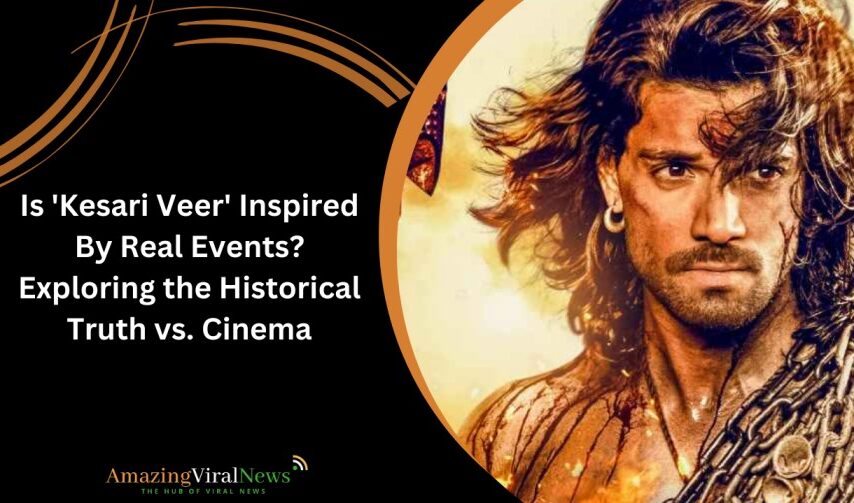The film Kesari Veer arrived with its trailer and musical accompaniment designed to stir the blood. It will, without doubt, rank among the notable historical pictures of this year. Yet behind the spectacle and narrative craft lurks a question that troubles many who might otherwise purchase tickets: does this story spring from actual events? The answer, though simple in form, proves complex in substance: it does, but only in part.
The man who inspired Kesari Veer was one Hamirji Gohil. His name belongs to the folklore and spoken histories of Gujarat, where men still repeat tales their grandfathers told them. But here we encounter a difficulty that plagues many such figures. When we demand proof—the kind that historians require—we find little solid ground beneath our feet. The boundary between what happened and what people wished had happened grows thin and finally disappears altogether.
Legendary Warriors & Historical Records
Consider the difference between this case and that of Chhaava, another recent film of similar ambitions. Chhatrapati Sambhaji Maharaj, the hero of that picture, left behind him a trail of documents, chronicles, and contemporary accounts. Scholars can point to specific battles, specific dates, specific policies. With Hamirji Gohil, no such luxury exists. His story lives in the realm where history and legend meet, shake hands, and become indistinguishable.
Who was Hamirji Gohil or The Real ‘Kesari Veer’?
What we can say of Hamirji Gohil amounts to this: he was a young warrior of Rajput blood, born into the Gohil line that once held power in those parts. Men say he died defending the temple at Somnath when Alauddin Khalji’s armies came to break its stones and steal its gold. The boy was sixteen years old, or so the stories go. He gathered what soldiers he could find and made his stand against forces that outnumbered him beyond counting. The enemy sought to defile the sacred place, and he died trying to prevent it.
His name survives in the songs that wandering singers still perform, carved into temple stones where pilgrims read them, and spoken aloud in the villages of Saurashtra when old men wish to teach young ones about courage. Yet he remains unknown to most Indians, unlike those heroes whose fame spread far beyond their native soil. Prithviraj Chauhan, for instance, achieved the sort of recognition that Hollywood producers understand—though this led to nothing better than the wretched film that bore his name in recent years.
Piecing Together the Past
The difficulty lies in the nature of the evidence itself. What stories we possess spring from the memories of communities and the pride they take in their past. They come to us through word of mouth, not through the careful records that scholars prefer. We searched for documents that might confirm the details, but found none that satisfied. The exact circumstances of his death remain unclear. Which particular assault on Somnath claimed his life? When did it happen? These questions have no solid answers.
This does not make his story a lie, but it places it in that uncertain territory where what happened and what people remember having happened become impossible to separate. Many regional heroes occupy this same shadowy ground.
Yet the legend possesses a power that documentation cannot provide. Throughout Gujarat, men still honor Hamirji’s memory. At Somnath itself, now rebuilt after centuries of destruction, a statue shows him mounted on horseback—a reminder carved in stone of what the community believes about its past.
Differentiating Between What is Fact & What is Fiction
We should judge Kesari Veer fairly. The film makes no claim to be a documentary, and we ought not expect it to behave like one. It presents itself as what it is: a story drawn from folklore and shaped for the screen. This places it in good company. Those Bollywood pictures that do claim historical accuracy rarely deliver it. They bend facts to serve drama, just as storytellers have always done. Bhansali transformed an old poem into visual spectacle when he made Padmaavat. The makers of Tanhaji took a real soldier’s life and wrapped it in fiction until the original man nearly disappeared beneath their inventions. In cinema, as in most human enterprises, the tale that can be sold matters more than the tale that actually happened.
Kesari Veer Release Date
The release date of Kesari Veer movie is 23 May 2025.
Star Cast of Kesari Veer
The picture reached audiences on 23 May 2025. Suraj Pancholi takes the central role, playing the young warrior whose story we have been examining. The producers have assembled around him a cast that includes Suniel Shetty, Vivek Oberoi, Akanksha Sharma, and Aruna Irani, along with others. Whether these actors can breathe life into a legend that exists mainly in the memories of one region remains to be seen.
Conclusion
That’s the story: Kesari Veer is caught between traditional stories and ambitious films, just like a tourist posing near the edge of a cliff. Whether Hamirji Gohil was a true hero or a mythical figure, it makes little difference compared to what you might expect. Still, Bollywood has always preferred a great sword fight and dramatic music over sticking to history. The film hits theaters this Friday in a bold fashion, hoping to change a local legend into something for the big screen. It is unclear if viewers will accept this version of Gujarat’s history or if Kesari Veer will end up like other historical epics that are rarely watched. Often, the legend alone is all we need.
FAQs
Q1: Is Kesari Veer based on a true story?
It depends—the cinematic version of a complicated situation. Hamirji Gohil, a young Rajput warrior, is the inspiration for the film’s story of defending Somnath temple from Alauddin Khalji’s forces. But finding solid proof from history is as difficult as finding a parking space at a packed movie theater on the first night it opens. The tale is mainly found in Gujarati folklore and the memories of the community.
Q2: Who was Hamirji Gohil in real life?
Hamirji Gohil was supposedly a 16-year-old member of the Gohil clan who fought his final battle at Somnath temple. He is like a regional folk hero in Gujarat, known by locals but not by many Indians. Although his story is passed down in village folklore and temple writings, historians hope for more records and less romance.
Q3: When is Kesari Veer releasing?
The movie will open in theaters on May 23, 2025.
Q4: Who stars in Kesari Veer?
In the lead role as the warrior, Suraj Pancholi is joined by Suniel Shetty, Vivek Oberoi, Akanksha Sharma and Aruna Irani. It looks like the producers decided to throw all kinds of actors together and see which ones would fit. We have yet to find out if they can turn local folklore into successful movies.











